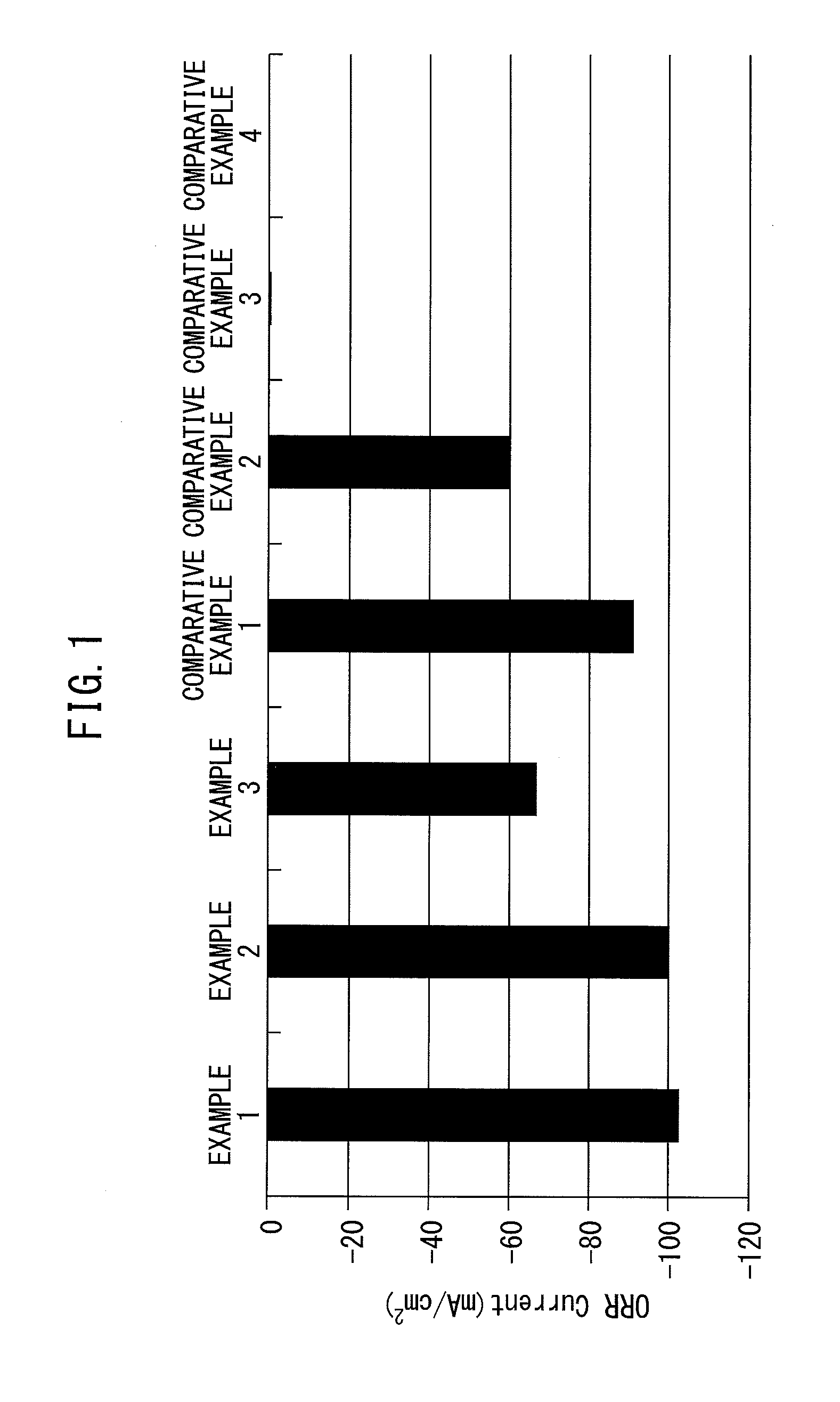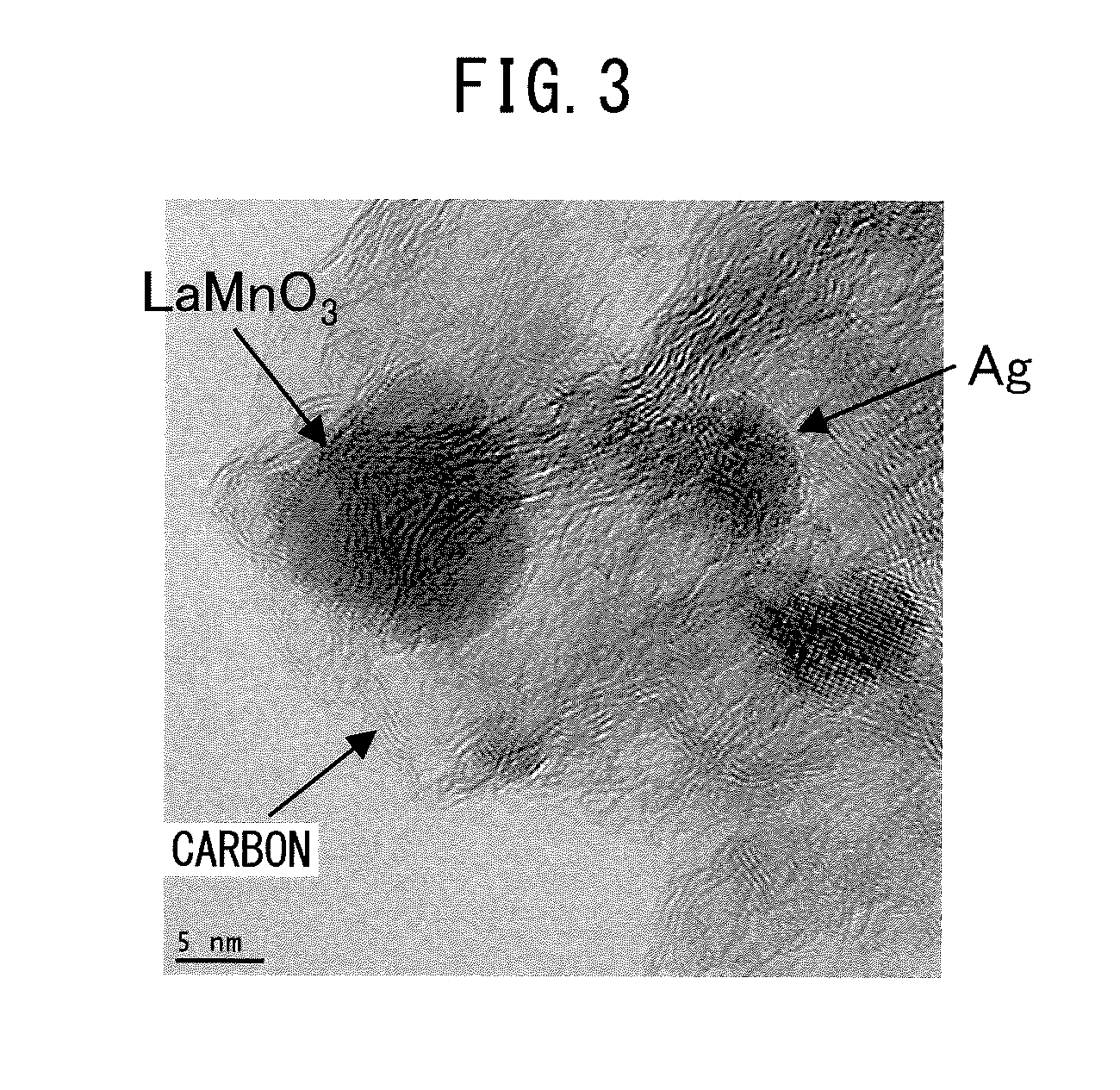Electrode catalyst
a technology of electrodes and catalysts, applied in the field of electrode catalysts, can solve the problems of oxidative decomposition of carrier carbon, achieve the effects of improving cycle durability, high oxygen dissociation capacity, and improving orr activity
- Summary
- Abstract
- Description
- Claims
- Application Information
AI Technical Summary
Benefits of technology
Problems solved by technology
Method used
Image
Examples
example 1
(1) Example 1
[0088]In the electrode catalyst of Example 1, extremely-good oxygen reduction activity was obtained. The details are as follows. FIG. 2 is a graph illustrating a CV measurement result of the electrode catalyst of Example 1. The vertical axis represents a (oxygen reduction reaction) current, and the horizontal axis represents a potential (vs. SHE). In the electrode catalyst of Example 1, an extremely-high oxygen reduction reaction current (−103 mA / cm2) and a high cycle property (difference of oxygen reduction reaction currents between cycles was small) were obtained. The reason is believed to be that the electrode catalyst of Example 1 included the perovskite-type oxide catalyst containing La, Mn and O elements and the metal catalyst containing a Ag element, which were located on the carrier containing C. In contrast, in the electrode catalyst in which the spinel-type oxide such as CuCoO4 and Co3O4 and Ag were supported on carrier carbon of Comparative Examples 3 and 4 a...
example 2
(2) Example 2
[0093]Also in the electrode catalyst of Example 2, extremely-good oxygen reduction activity was obtained. Specifically, in the electrode catalyst of Example 2, as illustrated in a CV measurement result of FIG. 5, an extremely-high oxygen reduction reaction current (−100 mA / cm2) and a high cycle property (difference of oxygen reduction reaction currents between cycles was small) were obtained. The reason is basically the same as the case of Example 1. In other words, this is because the perovskite-type oxide catalyst containing La, Mn, and O elements and the metal catalyst containing a Ag element were included on the C carrier, LaMnO3 and Ag were located extremely near, for example, within a range of 20 nm or less, as illustrated in a TEM photograph of FIG. 6, Ag was not encaptured or included by LaMnO3, the most part was a LaMnO3 phase as illustrated in an XRD measurement result of FIG. 7, and carbon was not burned down by the air calcination at the time of manufacturin...
example 3
(3) Example 3
[0095]Also in the electrode catalyst of Example 3, good oxygen reduction activity was obtained. Specifically, in the electrode catalyst of Example 3, as illustrated in a CV measurement result of FIG. 8, a high oxygen reduction reaction current (−67.4 mA / cm2) and a high cycle property (difference of oxygen reduction reaction currents between cycles was small) were obtained. The reason is basically the same as the case of Example 1. However, since the air calcination temperature was higher compared with the cases of Examples 1 and 2, the particle diameter tended to become slightly larger due to sintering of LaMnO3 and carbon tended to be slightly burned down, as illustrated in a TEM photograph of FIG. 9. Accordingly, the ORR current was slightly decreased compared with the electrode catalysts of Examples 1 and 2.
[0096]As described above, the above-described electrode catalyst of Example 3 has good characteristics.
PUM
| Property | Measurement | Unit |
|---|---|---|
| distance | aaaaa | aaaaa |
| particle diameter | aaaaa | aaaaa |
| particle diameter | aaaaa | aaaaa |
Abstract
Description
Claims
Application Information
 Login to View More
Login to View More - R&D
- Intellectual Property
- Life Sciences
- Materials
- Tech Scout
- Unparalleled Data Quality
- Higher Quality Content
- 60% Fewer Hallucinations
Browse by: Latest US Patents, China's latest patents, Technical Efficacy Thesaurus, Application Domain, Technology Topic, Popular Technical Reports.
© 2025 PatSnap. All rights reserved.Legal|Privacy policy|Modern Slavery Act Transparency Statement|Sitemap|About US| Contact US: help@patsnap.com



